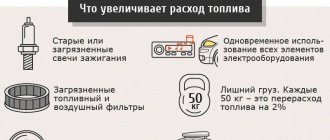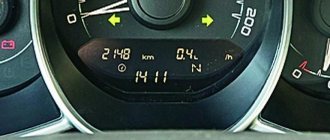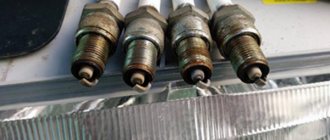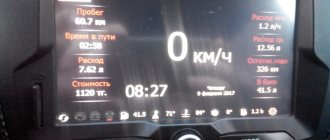The new Lada Vesta Cross station wagon went on public sale on October 26, 2017, and immediately attracted great attention from both fans of the domestic Automotive industry and skeptics.
An active discussion immediately began on specialized portals on the global network, especially the topic “real fuel consumption.” Today this is especially true due to the constant increase in gasoline prices, so potential car buyers pay special attention to these indicators and, as a rule, choose more economical models.
Fuel consumption characteristics for Lada Vesta
The manufacturer claims an average car consumption of 8.5 liters per hundred kilometers. In practice, the indicator differs upward.
The reasons for this are the following:
- style and manner of operating a technical device;
- type of pre-installed transmission;
- climatic features of the region;
- tire pressure indicator;
- frequency of use (activation) of additional equipment: radio, air conditioning, digital gadgets;
- speed mode;
- technical condition of the power unit.
City traffic jams “eat up” gasoline the most; daily downtime consumes more than a dozen liters at the end of the month.
Fuel consumption of HR16 DE-H4m engine (1.6, 117 hp)
The power unit from the French brand Renault with a volume of 1.6 liters and pre-installed mechanics runs on AI-92, AI-95.
Consumption in city mode - 8.1 l/100 km, highway - 5.4 l/100 km.
Such data is indicated by the manufacturer in the instruction manual. In practice, the figure is close to 9.5 - 10.0 liters per hundred. In order to reduce gasoline consumption on the HR16 DE-H4m engine, interested motorists install gas equipment.
With engine 1.6 106 hp
For this vehicle model, the base model of the power unit is an engine with a displacement of 1.6 liters, which is capable of delivering approximately 106 horsepower. The “engine” is a 16-valve version of the engine running on gasoline with an octane rating of 95. It is combined with a five-speed manual transmission or automatic transmission. Gasoline consumption of Lada Vesta according to factory data for various gearbox options can be as follows.
For “mechanics”, when driving in the city you will need 9.3 liters per 100 km, in city and highway conditions a little less than 6.9 l/100 km, and when driving on the highway only 5.5 l/100 km. For the automatic transmission, the gasoline consumption data is slightly less and amounts to 8.9-6.6-5.3 l/100 km, respectively. Manufacturers claim that when installing a robotic gearbox, fuel consumption will decrease slightly. From this we can conclude that with the right approach to operating the machine, you can achieve significant savings on the “mechanics”.
The car engine develops 106 horsepower, which is quite enough for comfortable movement both on the highway and in the city. Reviews from Lada Vesta owners about actual consumption can be found very different, which indicate that it largely depends on the driving style of the car, its operating conditions, and the fuel used. Most of them indicate increased indicators compared to factory data.
Reviews from Lada Vesta owners about fuel consumption
- Stanislav. Moscow city. I purchased a car from a dealership in January 2016. Today the mileage is almost 30 thousand km. Most of the time I move around the city, but sometimes I get out on the highway. At first, my Lada Vesta fuel consumption was about 12 l/100 km. After the engine was run-in, fuel consumption on the Lada Vesta decreased. In a city with traffic jams, no more than 11 liters are burned, on the highway about 7 l/100 km.
- Vladimir. G. Tula. I've owned the car for two years now. Under the hood there are 106 horses with a manual transmission, which is more than enough for me. I'm happy with the car, so far the only expenses are for maintenance and refueling. I trust only specialists to perform scheduled maintenance. My driving style is calm, so gas consumption for the Lada Vesta is very moderate. On the highway 5.5-6 liters per hundred. In the city it’s just over 10 liters.
- Victor. Novosibirsk city. In winter I became the owner of Vesta. There are no complaints about the car, the mileage is approaching 8 thousand km. I move mainly around the city. I take my wife to work, my children to school and kindergarten, then I head to my place of work. About 30 km are gained per day. My Lada Vesta SV Cross showed fuel consumption per 100 km as follows: - in a city with traffic jams up to 12 l/100 km; — on a country road approximately 7.5 l/100; - in a mixed cycle no more than 10 liters. I tried to calculate gasoline consumption based on actual mileage, and not on-board computer readings.
"Appetites" of the VAZ 21129 engine
On a domestic engine with a volume of 1.6 liters and 106 hp. "appetite" is as follows:
- Manual transmission: 9.3 l/100 km urban cycle and 5.5 l/100 km for the “highway”;
- Robotic version of the gearbox: 8.9 l/100 km “city” and 5.3 l/100 km “highway”.
Average consumption with a 1.6-liter engine is 7.1 liters per “hundred”. Recommended octane number: AI – 92, AI – 95.
Fuel consumption of Lada Vesta with different engines and gearboxes
I have already said above that fuel consumption can vary and depends not only on external factors, but also on the installed engine and gearbox.
Engine VAZ 21129
- In-line 4-cylinder 16-valve engine. It is a modified modification of the VAZ 21127. One of the most reliable and responsive engines in the VAZ line.
- Volume 1.6 l, power 106 hp. On Vesta Cross it is installed only with mechanics. Works great on AI-92 gasoline, although the recommended one is AI-95.
- Fuel consumption of the Lada Vesta SV Cross with engine 21129 is 7.5 l/100 km in the combined cycle, in the city - 9.7 l, and on the highway - only 6 liters.
Engine VAZ 21179
- Another in-line 4-cylinder 16-valve engine.
- Power 122 hp, volume - 1.8 l. It can work with both a 5-speed manual transmission and a robotic gearbox. In both cases, the consumption will be slightly different.
- 21179 and 5 manual transmission - consumption in the city is 10.7 liters per hundred, on the highway - 6.4 liters, and in the combined cycle - 7.9 liters
- 21179 and 5AMT - consumption in the city is 10.1 l/100 km, 6.3 l on the highway and 7.7 liters in the city.
Reasons for high gas consumption on Lada Vesta
The “appetite” of the car’s engine can be adjusted, but only with a pre-installed mechanical gearbox. It is more difficult to do this with the robotic option; a lot of practice and experience is required.
With a manual transmission, everything is simple: exceed the speed - increase the consumption, reduce it - reduce the consumption. The situation is similar with the choice of speed. Often, when overtaking or maneuvering, it is necessary to quickly accelerate; for this, the driver switches to a lower gear to complete the overtaking.
In such situations, uncontrolled consumption of gasoline occurs. During peak loads, the on-board computer shows up to 30 - 40 liters per hundred.
The robotic version of the gearbox consumes 1.0 - 1.5 liters more. You can save on AMT only outside the city, on a flat road where there are no ups or downs. In the “stale” mode at a speed of 90 – 95 km/h you will save up to five liters.
Operating AMT on uphills, downhills, and serpentines only increases consumption. Activated car equipment also takes away the fuel supply: air conditioning, radio, portable digital gadgets, lighting system.
In winter, the “appetite” increases due to the constant operation of the stove heater and warming up the engine before the trip. Uneven tire pressure is the most common cause of gas mileage. Owners rarely check tire pressure, which is one of the reasons for high gas mileage.
Gasoline acceleration and combustion indicators
For most car enthusiasts this will seem like a new product, but the stronger the braking and faster acceleration, the greater the fuel consumption per hundred kilometers.
Consumption 8.4l per 100km
Practice a moderate driving style, without jerking, without sudden changes from one gear to another. In addition, the robotic version of the gearbox does not like an aggressive driving style. Fuel with an octane number of AI - 92 burns faster and in greater quantities than AI - 95. Take this factor into account when refueling a vehicle and traveling long distances.
Reasons for increased fuel consumption of Lada Vesta Cross SV
It should be understood that the stated information on fuel consumption may not always coincide with the real ones. And this does not always mean that the car is faulty. Do not immediately panic and go to the service. It is important to understand why the consumption has become higher than stated. Perhaps the list of the main reasons that may increase the fuel consumption of your car will help you:
- Frequent acceleration and sudden braking.
- Inclusion of a large number of consumers. For example, turning on the air conditioner negatively affects gas mileage.
- Time of year - in winter, fuel consumption is always higher than in summer.
- Tire pressure and incorrect tire width.
- Long ride uphill.
- AI-92 gasoline burns faster than AI-95.
- Untimely gear shifting.
- Malfunction of the engine and its components.
How to reset the average fuel consumption on a Lada Vesta?
Unlike previous modifications of VAZs, resetting the fuel consumption meter on the Lada Vesta is not as easy as it might seem.
Sequencing:
- Squeeze the parking brake.
- We turn on neutral gear.
- We activate the ignition.
- Simultaneously press the two buttons of the left switch.
- In the on-board speedometer menu, select the “average consumption” category.
- Hold for 3 - 4 seconds, the indicators will start flashing.
- Release both buttons and press them again.
- We exit the menu.
There is another, less modern way, as they say, “old-fashioned”:
- We use the machine until the level warning lamp in the fuel tank lights up.
- Fill exactly 10 liters.
- Resetting the mileage counter.
- We reuse the machine until the indicator lights up again.
Still, do not forget about a moderate driving style - this is a real way to save dozens of liters of fuel.
Video - Reduce consumption
A new, unusual car from Tolyatti, the Lada Vesta, which appeared on the automobile market in 2015, immediately attracted the attention of both ordinary car enthusiasts and specialists. They are surprised by many things: good dynamics, high level of safety, appearance of the car, fuel consumption of the Lada Vesta. Today, many potential buyers are interested in the tactical and technical performance characteristics and fuel indicators before choosing one or another vehicle model.
Factors that increase consumption
- curb weight of the vehicle;
- engine volume;
- type of pre-installed gearbox;
- size, height, width of tires;
- style and manner of management;
- condition of machine components;
- frequency of use of equipment in the car;
- temperature regime overboard.
Conclusion
Regardless of the type of preinstalled transmission, it is quite possible to reduce the “appetite” of the motor if you adhere to the described recommendations.
To reduce fuel consumption as much as possible, fill with AI-95 gasoline. In suburban mode, do not exceed the average speed of 90 - 95 km/h. The maximum permissible threshold is 100 km/h.
There is an opinion that filling third-party chemical additives helps reduce the “appetite” of the engine, gives power and acceleration dynamics. Service station fuel workers are wary of such statements, as they believe that this is more a marketing ploy than real savings. Of course, the final decision is up to the owner of the technical device.
Reviews
| № | Positive |
| 1. | Nikolai Petrovich , 44 years old (otzovik.com): in my car the average consumption is about 6.5 liters per hundred. The indicator is good, before that there was a Priora, there was more. |
| 2. | Semyon Arkadyevich , 40 years old (www.zr.ru): I drive carefully, on the highway 90 - 95 km/h, no complaints about the fuel equipment. |
| 3. | Maxim , 22 years old (autobann.su): in general, I’m happy with the car, but at idle the speed suddenly increased (1100 rpm). My friends recommended replacing the fuel filter; it was most likely clogged. If it doesn’t help, then I’ll go to a service station for diagnostics. |
| 4. | Timofey , 33 years old (lada-vesta.net): the car is new, good price-quality ratio. This is not what was previously on previous modifications of Lada. |
| 5. | Arkady Gavrilovich , 43 years old (otzovik.com): my positive review of the Lada Vesta car. I live in a small town, it’s hard to find a better car. My recommendations for car enthusiasts. |
| 6. | Dmitry Semenovich , 45 years old (www.zr.ru): for the second year the car “sleeps” on the street, starts with a half-turn, the fuel pump works at 100%. |
| 7. | Vladimir , 20 years old (autobann.su): unlike the Lada Grant, Vesta has a number of advantages and improvements. Special thanks to the manufacturer for low gasoline consumption. |
| 8. | Vyacheslav Petrovich , 43 years old (lada-vesta.net): I drive around the city a lot, traffic lights, congestion, I expected more “appetite”, but Vesta is great, saves money. |
| 9. | Konstantin , 30 years old (otzovik.com): I take care of my equipment, carry out maintenance in a timely manner, I haven’t noticed any significant savings, but I’m happy with the car. |
| 10. | Gennady Stepanovich , 43 years old (www.zr.ru): over three years of operation, I contacted the service station several times for fuel equipment. Diagnostics did not reveal any critical breakdowns, just minor ones. I consider the consumption of 7.1 liters to be high for the Lada Vesta 1.8. |
| 11. | Vladislav , 35 years old (autobann.su): my positive review of the Lada Vesta, the car is economical, although not everyone agrees with this statement. |
| Negative | |
| 12. | Nikolaevich , 44 years old (www.zr.ru): I have a robotic version of the gearbox, it doesn’t show less than 8.4 liters per hundred. I think this is a lot, I will contact the service station for diagnostics under warranty. |
| 13. | Sergey , 27 years old (otzovik.com): in the urban cycle with a manual (Vesta 1.6) consumption is over 7.1 liters per hundred. According to the instructions, it should be less than 6.4 liters. I think this is a big expense for Vesta. |
| 14. | Mikhailovich , 45 years old (autobann.su): after a year of active use, I noticed a sudden increase in fuel consumption. I don’t know why this is so, obviously the fuel equipment has “flyed”. Comrades recommended contacting the official service under warranty. |











